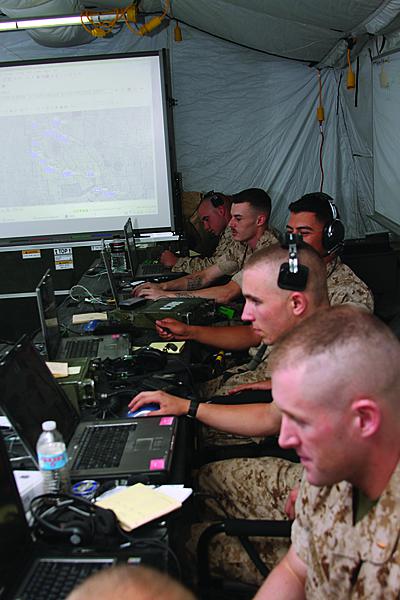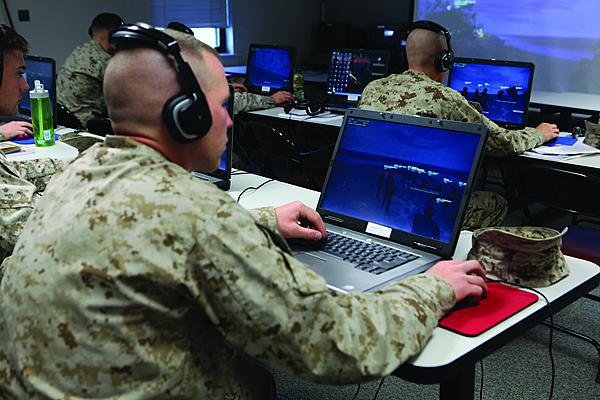NGEN Bidders Offer Continuity With Change
The program may be revolutionary, but its product is evolutionary.
Despite its sea-change approach to acquisition, the U.S. Navy’s Next Generation Enterprise Network program is being designed to evolve from its predecessor, the Navy Marine Corps Intranet, in bids submitted by the two teams vying for the multibillion-dollar contract. The two bidders are focusing their efforts on the transition between the two networks, which is a process that will take several years.
Two teams are competing for the ground-breaking Next Generation Enterprise Network (NGEN) program. One, led by Hewlett-Packard (HP), includes AT&T, IBM, Lockheed Martin and Northrop Grumman. The other, led by Computer Sciences Corporation (CSC) and Harris, includes Dell, General Dynamics and Verizon. They have submitted bids based on an request for proposal (http://bit.ly/signalngen0512) issued by the Navy earlier this year. NGEN is designed to replace the Navy Marine Corps Intranet (NMCI) early next year (SIGNAL Magazine, December 2011, page 18, “NGEN Race Heats Up”).
The teams offer varying emphases on the value of their proposals. However, they both stress the importance of the transition from the NMCI to NGEN, and they state that their proposals are designed to ensure stability while easing in innovation.
Bill Toti, vice president and account executive, HP Navy and Marine Corps Accounts, offers that his team’s bid is strengthened by the fact that the team includes the progenitors of the NMCI. “We’re the only people who have ever done this,” he declares, adding that this is a consideration that the Navy will have to take into account during source selection.
Toti continues that the NMCI effort “was instructive in many ways” for EDS, which became part of HP in 2008. “I think it was for the Navy as well. A lot of things that they thought would be simple extensions of how they were doing business in the past turned out not to be simple and not to be extensions.” As a network grows in size, it becomes a nonlinear problem with difficulties and challenges growing significantly, requiring new solutions, he adds. “The solutions that work for 20,000 users don’t work for 800,000 users. You can’t just multiply the same solution by 100 to get it to work.”
He continues that some of these NMCI lessons were learned “catastrophically.” Now that the lessons have been learned and internalized into the system, HP and its team are well-positioned to take the next step seamlessly, Toti states, especially with regard to the transition.
Steven J. Ashworth, lead executive and NGEN bid program manager, CSC, believes that his team is replete with incumbent expertise and is forward-focused. It also has a great deal of technical expertise in dealing with government and industry, which will enable it to provide the Navy with the right mix for transitioning from the NMCI to NGEN with minimal risk.
Ashworth cites his team’s technical approach as its greatest strength, particularly in how it has harvested best of breed from each partner. He offers that the team composition is among the proposal’s strongest selling points. Each member provides capabilities that, in sum, provide the Navy with network command and control as well as needed transparency for the network.
“The approach we are taking is one of transition, stabilize and innovate,” Ashworth states. “That provides the Navy with a comfort level that we can, with proper risk mitigation factors, transition from NMCI—in a contractor-owned, contractor-operated environment—to NGEN, which is a government-owned contractor environment with minimal risk while providing the Navy with the level of oversight and command and control of their networks that they are looking for.”
Cynthia Gagnon, director of capture at Harris IT Services Corporation, adds that another strength of the CSC-Harris proposal is that the team has approached the program in the way that the government was seeking to evaluate the bid. This perspective entails developing the program in segments as well as the composite entirety. “We’ve done a thorough job and analysis in looking at the requirements for both the Navy and the Marine Corps with respect to the segments as well as the combined, and we’ve worked very hard at integrating the coordination both technically and management-wise at the seams between the transport and the enterprise segments. And, we’ve given the government the options to evaluate and manage it from either direction,” she offers.
Ashworth notes that much of the request for proposal (RFP) involves the transition from the NMCI. The lengthy transition, which runs through December 2014, must be completed with the network stabilized before innovation is introduced. These innovations will include leading-edge technologies, big data, cloud computing and cybersecurity.
 Marines monitor network operations during a command post exercise. Transparency will be a key element in NGEN as the network assumes full operation.
Marines monitor network operations during a command post exercise. Transparency will be a key element in NGEN as the network assumes full operation.He explains that his team’s approach to the transition was to develop a joint solution that emphasized seam management. This would ensure that no gaps existed in the solution it offered to the government, particularly with regard to the enterprise and transport segments in the transition. Gagnon adds that the team members have worked together on transitioning other contracts similar in scope and scale.
“We were very diligent about scrutinizing our team members—both our large partners as well as our small business partners—on what all of the partners collectively bring, not only the technical and functional capabilities but history and past performance and mission awareness,” she says.
The change from the NMCI approach—where the commercial provider owned the network—and the NGEN approach in which the government owns and defines the network will not change the basic nature of the network. “The contract is different, but the network starts with the network we have today,” Toti states. “The network still is a large, fully integrated, enterprise-level network.”
Gagnon notes that her team has submitted prime bids for the enterprise segment, the transport segment and the combined segment. This gives the government alternative scenarios in which it can award contracts to two separate primes or to a single combined bid. She adds that these proposals give the government “in-depth visibility” into all of these elements.
The criteria for selection call for a technically acceptable, lowest-cost solution. Both teams state that their offerings meet that criteria directly.
Toti says that his team’s first focus was on lowering cost “in ways that won’t break [NGEN]. It’s easy to lower the cost if you don’t know what will break it; but we’re burdened by the knowledge that we do know what will break, and we’ll have to live with the consequences of what we bid.”
Ashworth offers that the CSC-Harris team will be giving the government “every option in technology, capabilities and management” that team members can generate. It is important for the program management office to have a close relationship with the Department of the Navy to ensure that additional requirements or options are addressed jointly when they emerge. This transparency is a key Navy goal, he re-emphasizes.
Network security is of paramount concern to the Navy and to both bidding teams. Ashworth says that his team is using “industry best practices” for providing defense-in-depth cybersecurity. It is tapping the tools available from each of its member companies.
Toti also says that his team has taken “a best of breed approach leveraging the strength of our partners.” He notes that the team examined the security solution in Northrop Grumman’s successful Consolidated Afloat Networks and Enterprise Services (CANES) bid. The other partners also bring security solutions based on their own individual information technology and networking expertise. Cyberforensics is one area that is valuable for building network security, he observes. As with other network elements, cost did play a role in determining their NGEN security solution.
Gagnon states that the CSC-Harris team did not come across any surprises in building its proposal. She credits the government response to bidder input and RFP amendments, along with a “fluid, adaptive and responsive team” that dealt with updates. Each member had assigned roles for addressing requirements.
Toti admits that the HP team did encounter some surprises. The different points of view brought to the table by the partners provided some “eye-opening” moments. However, some of these perspectives came with too high a price to be worked into the bid when their solutions only provided marginal improvement. No unexpected hurdles emerged for the HP team, which Toti again attributes to his company’s NMCI experience.
The part of the HP team’s proposal that represents the biggest departure from the NMCI relates more to the partnership than the network, Toti offers.
“You have to play out in your mind, ‘How far does this customer want us to go in reducing the cost? How far do they want us to get to that line? What do they really consider technically acceptable to be?’ Translating those questions led to most of our internal dialogue,” he relates.
Potential subcontractors posed a different type of challenge. “We had a lot of vendors come in with their ‘wonderful shiny solution’ and start their conversations with the words, ‘We pitched this to the Navy and they loved it,’” Toti relates. “My response almost always was, ‘There’s not a requirement for it; and if they loved it so much, they could have written it into the requirements. There is no way we’re going to fold something into the solution that is not a requirement and raise costs in a price shootout.’ So, there were a lot of disappointed vendors.”
Both the NMCI and NGEN feature off-the-shelf components, either commercial or government. Toti explains that his team’s bid starts with off-the-shelf components “almost exclusively;” more than half of the original components are commercial. However, many commercial off-the-shelf products must be modified to work in a defense network this large.
Even government off-the-shelf components can require modification, especially in security products. “I can’t think of a single piece of government off-the-shelf software that works out of the box on this network,” Toti says. “They all have to be engineered to work in this environment.”
Ashworth says that government-furnished equipment will be a major stabilizing element during the transition. Once the network is stabilized, then both commercial and government off-the-shelf elements will be tapped.
Not only does NGEN represent a new way of network acquisition, it also represents a new way of network management. “There are skills that the government is going to have to relearn as it takes control of the network,” Toti predicts. “The Marine Corps is doing that today, and from my perspective, it has gone really well. We have committed our companies’ reputations on making sure that the network doesn’t fall apart as that transition takes place.”
Toti relates that he still was in uniform when the NMCI came into existence. Back then, the general opinion was that Navy and Marine Corps information technology consisted of business systems, office systems, PowerPoint, Excel spreadsheets and reports written in Microsoft Word, he says. The Navy failed to understand then that the NMCI was a tactical system and an operational system as well.



Comments